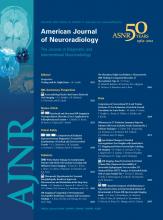Research ArticlePediatrics
The Shrunken, Bright Cerebellum: A Characteristic MRI Finding in Congenital Disorders of Glycosylation Type 1a
P. Feraco, M. Mirabelli-Badenier, M. Severino, M.G. Alpigiani, M. Di Rocco, R. Biancheri and A. Rossi
American Journal of Neuroradiology December 2012, 33 (11) 2062-2067; DOI: https://doi.org/10.3174/ajnr.A3151
P. Feraco
aDepartments of Pediatric Neuroradiology (P.F., M.S., A.R.)
M. Mirabelli-Badenier
bInfantile Neuropsychiatry (M.M.-B., R.B.)
M. Severino
aDepartments of Pediatric Neuroradiology (P.F., M.S., A.R.)
M.G. Alpigiani
cPediatrics (M.G.A.)
M. Di Rocco
dPediatrics II (M.D.R.), G. Gaslini Children's Hospital, Genova, Italy.
R. Biancheri
bInfantile Neuropsychiatry (M.M.-B., R.B.)
A. Rossi
aDepartments of Pediatric Neuroradiology (P.F., M.S., A.R.)

References
- 1.↵
- Jaeken J,
- Artigas J,
- Barone R,
- et al
- 2.↵
- Pagon RA,
- Bird TD,
- Dolan CR,
- et al.
- Sparks SE,
- Krasnewich DM
- 3.↵
- Pearl PL,
- Krasnewich D
- 4.↵
- 5.↵
- Jensen PR,
- Hansen FJ,
- Skovby F
- 6.↵
- Steinlin M,
- Blaser S,
- Boltshauser E
- 7.↵
- 8.↵
- Raininko R,
- Autti T,
- Vanhanen SL,
- et al
- 9.↵
- 10.↵
- Boltshauser E
- 11.↵
- Lemire RJ,
- Loeser JD,
- Leech RW,
- et al
- 12.↵
- 13.↵
- Barkovich AJ,
- Millen KJ,
- Dobyns WB
In this issue
Advertisement
The Shrunken, Bright Cerebellum: A Characteristic MRI Finding in Congenital Disorders of Glycosylation Type 1a
P. Feraco, M. Mirabelli-Badenier, M. Severino, M.G. Alpigiani, M. Di Rocco, R. Biancheri, A. Rossi
American Journal of Neuroradiology Dec 2012, 33 (11) 2062-2067; DOI: 10.3174/ajnr.A3151
Jump to section
Related Articles
- No related articles found.
Cited By...
- A Proposed Clinical Classification and a Diagnostic Approach for Congenital Ataxias
- Typical MRI features of PLA2G6 mutation-related phospholipase-associated neurodegeneration (PLAN)/infantile neuroaxonal dystrophy (INAD)
- Clinical, laboratory and molecular findings and long-term follow-up data in 96 French patients with PMM2-CDG (phosphomannomutase 2-congenital disorder of glycosylation) and review of the literature
- Diffusion Tractography Biomarkers of Pediatric Cerebellar Hypoplasia/Atrophy: Preliminary Results Using Constrained Spherical Deconvolution
This article has been cited by the following articles in journals that are participating in Crossref Cited-by Linking.
- Thangamadhan Bosemani, Gunes Orman, Eugen Boltshauser, Aylin Tekes, Thierry A. G. M. Huisman, Andrea PorettiRadioGraphics 2015 35 1
- Andrea Poretti, Eugen Boltshauser, Dan DohertyAmerican Journal of Medical Genetics Part C: Seminars in Medical Genetics 2014 166 2
- Tessa van Dijk, Frank Baas, Peter G. Barth, Bwee Tien Poll-TheOrphanet Journal of Rare Diseases 2018 13 1
- Dan Doherty, Kathleen J Millen, A James BarkovichThe Lancet Neurology 2013 12 4
- Manuel Schiff, Céline Roda, Marie-Lorraine Monin, Alina Arion, Magali Barth, Nathalie Bednarek, Maud Bidet, Catherine Bloch, Nathalie Boddaert, Delphine Borgel, Anaïs Brassier, Alexis Brice, Arnaud Bruneel, Roger Buissonnière, Brigitte Chabrol, Marie-Chantal Chevalier, Valérie Cormier-Daire, Claire De Barace, Emmanuel De Maistre, Anne De Saint-Martin, Nathalie Dorison, Valérie Drouin-Garraud, Thierry Dupré, Bernard Echenne, Patrick Edery, François Feillet, Isabelle Fontan, Christine Francannet, François Labarthe, Cyril Gitiaux, Delphine Héron, Marie Hully, Sylvie Lamoureux, Dominique Martin-Coignard, Cyril Mignot, Gilles Morin, Tiffany Pascreau, Olivier Pincemaille, Michel Polak, Agathe Roubertie, Christel Thauvin-Robinet, Annick Toutain, Géraldine Viot, Sandrine Vuillaumier-Barrot, Nathalie Seta, Pascale De LonlayJournal of Medical Genetics 2017 54 12
- Justyna Paprocka, Aleksandra Jezela-Stanek, Anna Tylki-Szymańska, Stephanie GrunewaldBrain Sciences 2021 11 1
- Antonio F. Martínez‐Monseny, Mercè Bolasell, Laura Callejón‐Póo, Daniel Cuadras, Verónica Freniche, Débora C. Itzep, Susanna Gassiot, Pedro Arango, Didac Casas‐Alba, Eugenia de la Morena, Javier Corral, Raquel Montero, Celia Pérez‐Cerdá, Belén Pérez, Rafael Artuch, Jaak Jaeken, Mercedes SerranoAnnals of Neurology 2019 85 5
- Mercè Izquierdo-Serra, Antonio Martínez-Monseny, Laura López, Julia Carrillo-García, Albert Edo, Juan Ortigoza-Escobar, Óscar García, Ramón Cancho-Candela, M Carrasco-Marina, Luis Gutiérrez-Solana, Daniel Cuadras, Jordi Muchart, Raquel Montero, Rafael Artuch, Celia Pérez-Cerdá, Belén Pérez, Belén Pérez-Dueñas, Alfons Macaya, José Fernández-Fernández, Mercedes SerranoInternational Journal of Molecular Sciences 2018 19 2
- Christina T. Rüsch, Bigna K. Bölsterli, Raimund Kottke, Robert Steinfeld, Eugen BoltshauserThe Cerebellum 2020 19 4
- Ahmed Abdel Khalek Abdel Razek, Mauricio CastilloJournal of Computer Assisted Tomography 2016 40 1
More in this TOC Section
Similar Articles
Advertisement










